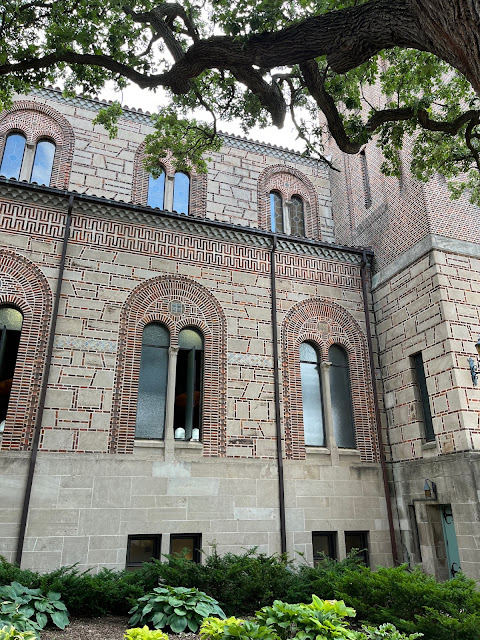To many upon first sight the interior may appear to be of genuine stone. However, it is not. The interior decoration is made entirely of tiles, with a brick Gustavino ceiling. The decorative tiles, known as "Batchelder" tiles, are made to look like stone and stone carvings, with sometimes intricate molds seen in the capitals that cap the columns.
Batchelder was able to articulate, as no other, the value and importance of tilework as an integral part of the Arts and Crafts movement. His highly distinctive tiles were hand-crafted in kilns that were originally located in his Pasadena back yard, where in 1909 he built his own house. In his day Batchelder tiles were considered minimalist in design and modern in character, giving a fresh new feel to tile art. The elegant simplicity was well suited to the times, evoking a nostalgia for previous centuries before the Renaissance, with a whimsical touch in many of the tile designs.
Upon inspection Batchelder tiles are intentionally discolored. Many of them reveal a primary wash of faint color, with a hint of pale blue. The designs draw on Medieval themes and include Byzantine motifs such as flowers, and different renditions of the cross. The walls seen here in the chapel are covered in cocoa-brown tiles, resemble genuine building stones, making a brilliant worship space with the satisfying feel of a stone chapel from the Middle-Ages.
Batchelder as an artist gave ceramic tile a new name and a new lease on life, putting it on the map as a viable element in decorating both the interior and exterior of the chapel, while using tile elements also on the outside of the chapel. Batchelder tiles were made so well that they have survived the test of time with the chapel naturally shifting over the years in addition to exterior tilework surviving harsh outdoor conditions and brutal winters. Even the Stations of the Cross in the chapel, made in bas-relief, were made by Batchelder - they are actual single tiles attached to the walls.
The Our Lady of Victory Chapel is a preeminent example of Batchelder's ecclesiastical design work, one of the best examples in the nation of a church he decorated. The innovative look with a Medieval motif makes this one of my all-time favorite churches in North America. As a child I walked here many times to pray alone in the dark, as I grew up in the neighborhood. Readers are encouraged to visit and admire the symphony of tilework seen especially in the rear of the church around the choir gallery.
In truth, every tile manufacturer in those days had their own trade secrets and formulations. Batchelder was in some ways a brilliant chemist, mixing different types of mineral with silica to create his own coloration. In all his tiles he preferred soft color schemes and matte finishes, all part of his signature look. This gave the tiles faded effects of old age, extenuated by devotional images such as peacocks and vines, wheat, and grapes, and so many other interesting combinations.
The process of Batchelder tile making is described below, taken from Batchelder's Wiki page:
"The style in which Batchelder worked was highly distinctive. First, he used a single-fire process known as engobe in which a primary wash of colored clay slip (usually pale blue) was applied to the surface of the tile before being fired, pooling in the recesses of the design, with excess being wiped off. Then the tile was fired. A typical glazed tile is fired twice–once before glaze, and once after, thereby sealing in the added color. Batchelder's designs often drew on Medieval themes but also included flowers, vines, and California oaks; birds, particularly peacocks; Mayan patterns; Byzantine themes; and geometric shapes."
Below are a handful of additional pics that help to give a glimpse of the brilliant technique of Batchelder's vintage tiles. Hopefully they will inspire a new generation of ecclesiastical tile-makers to follow in his footsteps and help beautify modern church construction.

























